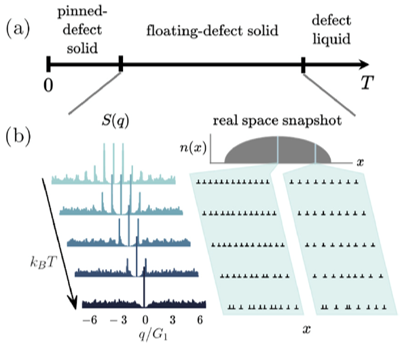Statistical Mechanics of Dislocation Pileups
in Two Dimensions

A team at the Harvard MRSEC led by Nelson has studied the statistical mechanics of dislocation pileups embedded in two-dimensional crystals, where the dislocations themselves form one-dimensional lattices. Two types of phase transitions were observed by comparing theory to numerical experiments. As temperature increases, a thermal depinning transition out of long-range order from the pinned-defect phase to the floating-defect state occurs followed by melting to a defect liquid. This set of transition temperatures can be directly observed through the 1D structure factor, where the delta function Bragg peaks, at the pinned- to floating-defect transition broaden into diverging Bragg peaks, which then subsequently disappear as the melting transition is approached. These predictions are now being explored experimentally (Spaepen) via 4D imaging of interacting dislocations within colloidal crystals to yield new insights on the behavior of crystalline solids.
Publication:
Zhang, G.H. and Nelson, D.R., "Statistical mechanics of dislocation pileups in two dimensions," Physical Review E 103 (2-1):022139 (2021) ![]()
![]()
David R. Nelson (Physics), and
Frans Spaepen��� (Material Science)
2020-2021 Harvard MRSEC (DMR-2011754)
